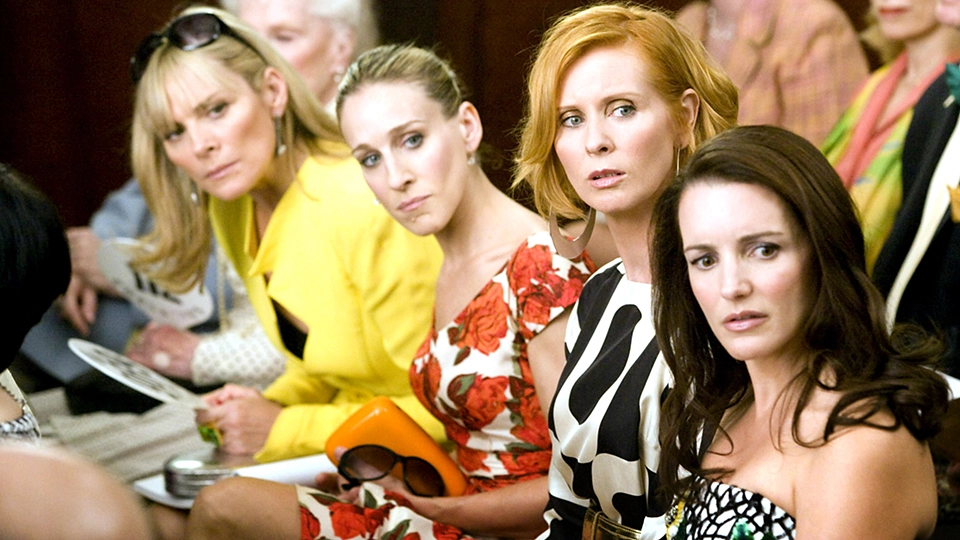It was 9:00 am and I was stuck in early traffic, listening to the BBC news, as is my way. On this morning, the hosts were celebrating HBO’s anniversary by reminiscing about their favorite shows on the network. They set it up so listeners would think of the intro music to their go-to show when they heard that grainy “ahh” iconic of the United States network. One of the older announcers said the intro made him think of Twin Peaks. His colleague, a woman my age, said she couldn’t help but think of the music from Sex and the City, “like all women of my generation.”
Amid the traffic, it dawned on me that the SATC cultural phenomenon shaped the lives of almost every woman my age, but I had no part in it. Call it FOMO or curiosity, but I couldn’t help but wonder…

Why is Sex and the City a Cultural Phenomenon?
You don’t have to be a marketing genius to know that putting “sex” in the title got you eyeballs in the late 90s. But what made Sex and the City the cultural phenomenon it is today?
As a virgin of SATC, I decided to devour the series in record time. For the uninitiated, it’s about four characters – Carrie, Miranda, Charlotte, and Samantha – who approach life in the metropolis of New York from the urgency of sexual interaction. Which is to say, they approach both sex and their life decisions around the same organizing principle – for Carrie, it’s the intellectuality of the potential act, for Miranda, it’s professional objectivity, Charlotte follows the myth of fairy tales, and Samantha is all about the visceral and the underlying pornographic narrative.
Of course, that doesn’t match my reality. I understand, that for women, sexuality is not linear. Instead, it is interwoven with fears, anxieties, trauma, and the accumulating rust of a hetero-patriarchal society. As the seasons went on, and being thirty myself, many of the debates hashed out in the series began to hit home, better touching on some truths about womanhood and sex.

Sex and the City or the Urge to Feel Full
Inspired by Candace Bushnell’s book, SATC’s story has gaps that the screenwriters, and consequently, the characters, seek to fill with each passing episode. As a result, it’s not just Carrie’s irreverent collection of clothes and shoes but the emotional emptiness that her co-stars fill with failed love stories, successful careers, huge penises, or a love named “Big.”
For a writer and editor who has been a freelancer for most of her professional life, I laughed out loud at Carrie’s apartment, her penchant for Manolo Blahnik shoes, and her nightlife. I had to make a superhuman effort to really put myself in her wealthy context and fall in love with the characters.
But I went ahead and tried, as Sex and the City is a symptom, not a diagnosis, of a society in transition.
In one way or another, the characters are tangents of the same femininity that entered the 21st century with the wrong tools. If we overlook the incongruities in the narrative, and if we strive to take Carrie Bradshaw seriously, Sex and the City opens as a neurotic encyclopedia of what ails us women, at any point in history, as we pass 30.
Is there such a thing as satisfaction or is it a self-imposed impediment? How genuine is the possibility of meeting “the one”? Is there only one or do we get multiple chances? Why is it so hard to understand that women also need sex with no strings attached? Is motherhood the goal or an obstacle?
Almost thirty years after the premiere of Sex and the City the questions remain the same. And perhaps that’s why the show endures.

It Should Have Been Samantha and the City
Watching it now, I can’t help but say it was a mistake to make Carrie Bradshaw the main character. I fully understand that, for the time, the “damsel in distress” needed to be redefined, but I’ve never been so annoyed by a character in a series, not even Michael in The Office.
The supposed writer’s immaturity, her errors in judgment, and her inability to make herself a cup of coffee at home just make so much noise.
However, I was pleasantly surprised to realize that Sex and the City gave us one of the best characters on television, second only to Tony Soprano: Samantha Jones.
A woman between desires and thoughts and thoughts and feelings. A woman who lives sexuality as we should all live it: without apologies. A character who strips herself layer by layer, who lives voraciously, loves, and experiences heartbreak, fears of menopause, and even cancer.
If there is a character who has paid homage to femininity, it is undoubtedly Samantha Jones. So as a neophyte to the cultural phenomenon of Sex and the City, I can’t help but wonder what the show could have been like with her at the center.
And what an error it is to have a sequel in Just Like That… that erases her completely rather than celebrating how she alone embodies the original show’s title.

